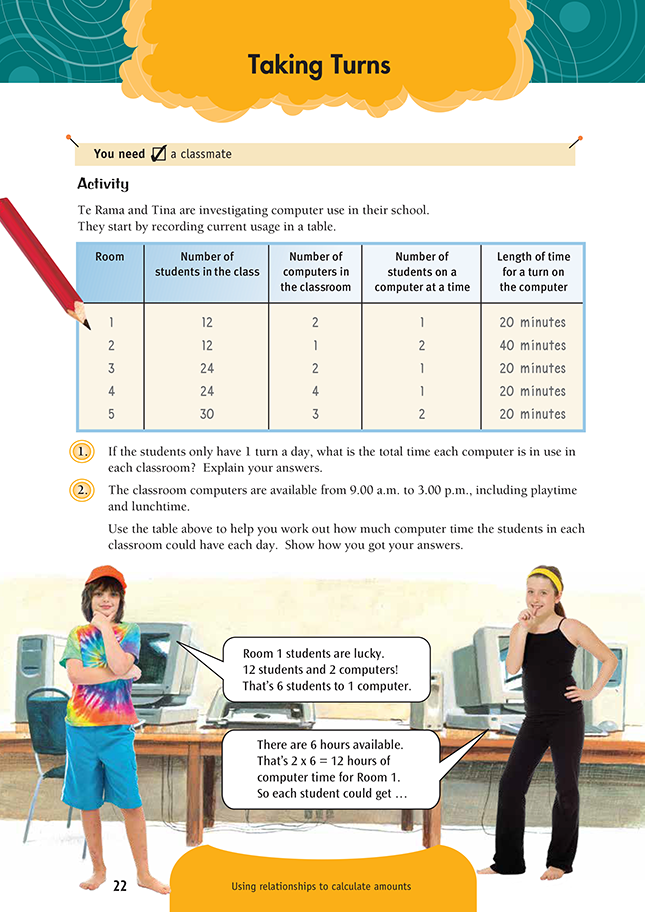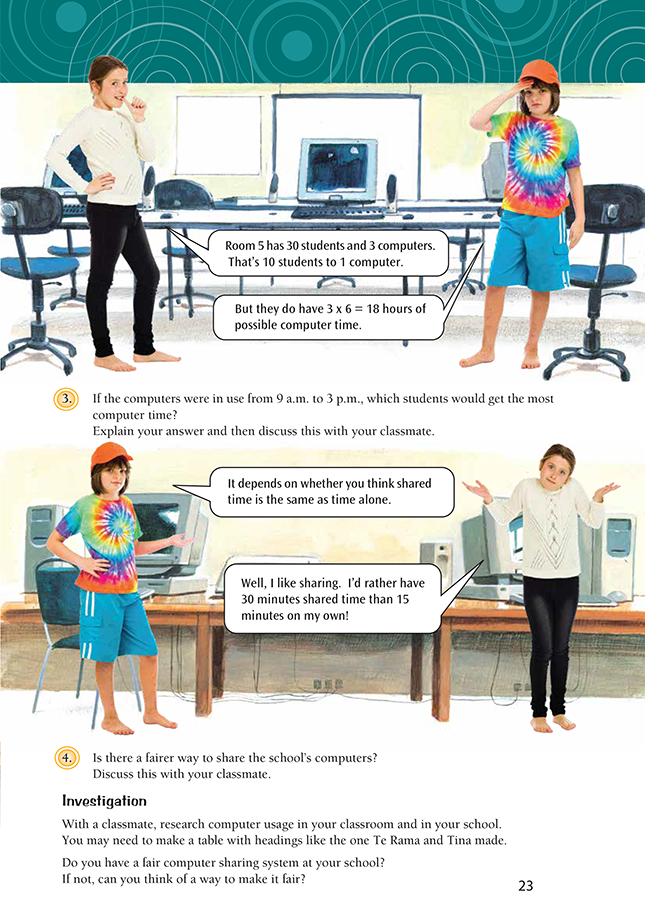This is a level 4 number activity from the Figure It Out series. It relates to Stage 7 of the Number Framework.
A PDF of the student activity is included.
Click on the image to enlarge it. Click again to close. Download PDF (394 KB)
solve problems involving simple proportions
Number Framework Links
Use this activity to help students apply advanced multiplicative part–whole (stage 7) strategies in the operational domains of multiplication and division and proportions and ratios.
FIO, Level 3, Number Sense and Algebraic Thinking, Book One, Taking Turns, pages 22-23
A classmate
In this activity, students compare computer access times across classes that have different numbers of students and computers, using relationships in a table of information to make calculations and comparisons. For this activity, students need to be multiplicative part–whole thinkers, preferably advanced (stage 7). Time has a base of 60, not 10, so be alert for potential problems if the students do not take this into account.
Some students in a guided teaching group may need assistance to use the information in the table. Ask supporting questions for question 1, such as:
How many students are in Room 1?
If each of those students uses a computer for 20 minutes, how much computer time is that? How did you work that out?
There are 2 computers in Room 1. If the computers are used for a total of 4 hours, how long is each computer used for on average?
What maths did you use to work this out? Can you write what you have done as number sentences?
(12 students x 20 minutes ÷ 2 computers = 120 minutes (2 hours) for each computer. 12 x 20 ÷ 2 = 120)
Can you use this same process for the other classrooms?
If students need assistance for question 2, ask supporting questions such as:
What clues can you find in Te Rama and Tina’s speech bubbles?
How many hours could the computers be used for?
Room 1 has 2 computers, so how many hours of computer time are available?
If there is 12 hours of computer time available, how much could each student in Room 1 get?
An alternative strategy is outlined in the Answers.
Investigation
To encourage reflective discussion, discuss findings from the investigation and any recommendations the students have for improving your school’s or classroom’s computer sharing system.
Answers to Activity
1. Room 1:
2 hrs. 12 x 20 = 240 min. 240 ÷ 60 = 4.
4 hrs ÷ 2 computers = 2 hrs per computer.
Or: 12 students at 2 computers is 6 students`
per computer.
6 x 20 min = 120 min or 2 hrs per computer.
Room 2:
4 hrs. 6 pairs x 40 min = 240 min, which is 4 hrs.
Room 3:
4 hrs. 24 x 20 = 480 min, which is 8 hrs.
8 hrs ÷ 2 computers = 4 hrs per computer.
Or: 24 students at 2 computers is 12 students per computer. 12 x 20 min = 240 min or 4 hrs per computer.
Room 4:
2 hrs. 24 x 20 = 480 min, which is 8 hrs.
8 hrs ÷ 4 computers = 2 hrs per computer.
Or: 24 students at 4 computers is 6 students per computer. 6 x 20 min = 120 min or
2 hrs per computer.
Room 5:
1 hour 40 min. 15 pairs x 20 = 300 min.
300 min ÷ 3 computers = 100 min per computer, which is 1 hr 40 min. Or: 30
students at 3 computers in pairs is 5 pairs per computer. 5 x 20 min = 100 min, which is 1 hr 40 min.
2. Strategies will vary. Note that the school day is 6 hrs (9 a.m.–3.00 p.m.)
Room 1:
1 hr per day per student
Possible working: 12 students at 2 computers is 6 students per computer.
6 hrs shared between 6 students is 1 hr each.
Room 2:
1 hr per day per pair (shared time)
Possible working: 12 students share 1 computer in pairs, so there are 6 pairs.
6 hrs shared between 6 pairs is 1 hr per pair.
Room 3:
30 min ( hr) per day per student Possible working: 24 students at 2
computers is 12 students per computer. 6 hrs shared between 12 students is 30 min
each.
Room 4:
1 hr per day per student
Possible working: 24 students at 4 computers is 6 students per computer.
6 hrs shared between 6 students per computer is 1 hr each.
Room 5:
1 hr 12 min per day per pair (shared time)
Possible working: 30 students in pairs is 15 pairs. 15 pairs at 3 computers is 5 pairs
per computer.
6 hrs shared between 5 pairs is 72 min or 1 hr 12 min each
3. Answers may vary. Room 5 students could get the most time, but it is in pairs. Rooms 1 and 4 students could get the most time by themselves on the computer. You could argue that Room 5’s time is less hands-on time per student
because Room 5 students work in pairs, so they could only interact with the computer half of their time, or 36 min.
4. Answers will vary. There are 12 computers and 102 students. There should be 1 computer for every 8.5 students (1:8.5), but it is not possible to share them evenly because of the class numbers. If all the students used the computer in pairs or if they all used them individually, it would be fairer if Rooms 1 and 2 both had 1 computer each (1:12), Rooms 3 and 4 both had 3 computers each (1:8), and Room 5 had
4 computers (1:7.5). It would be even fairer if the school bought an extra computer for Rooms 1 and 2 to share because then they would have a ratio of 1 computer for every 8 students (1:8 instead of 1:12). Another alternative is for
Rooms 1 and 2 to share 3 computers (1:8), Rooms 3 and 4 to have 3 computers each (1:8), and Room 5 to have 3 computers (1:10).
Investigation
Results will vary.

